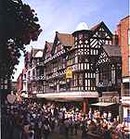
Eastgate is built in red sandstone and consists of a wide central arch, with rusticated jambs and voussoirs, and a small pedestrian arch on each side. Eastgate and Eastgate Clock in Chester, Cheshire, England, stand on the site of the original entrance to the Roman fortress of Deva Victrix. It is a prominent landmark in the city of Chester and is said to be the most photographed clock in England after Big Ben.
The original gate was guarded by a timber tower which was replaced by a stone tower in the 2nd century, and this in turn was replaced probably in the 14th century. The present gateway dates from 1768 and is a three-arched sandstone structure which carries the walkway forming part of Chester city walls. In 1899 a clock was added to the top of the gateway to celebrate the diamond jubilee of Queen Victoria two years earlier. It is carried on openwork iron pylons, has a clock face on all four sides, and a copper ogee cupola. The clock was designed by the Chester architect John Douglas. The whole structure was listed by English Heritage on 28 July 1955 as a Grade I listed building.
Source & More Information: Wikipedia, Eastgate and Eastgate Clock, http://en.wikipedia.org/wiki/Eastgate_and_Eastgate_Clock



